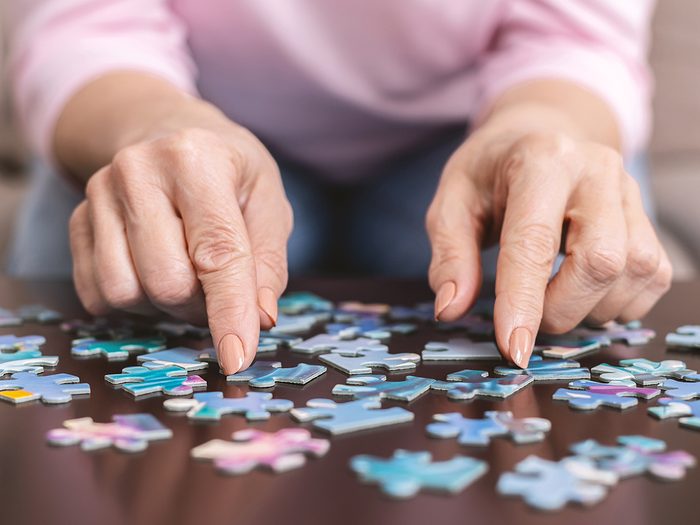Why a Jigsaw Puzzle Could Be the Best Antidote For Your Anxiety

Jigsaw puzzles, the ultimate parlour activity of yore, are gaining popularity as a 21st century way to deal with stress.
While out shopping for Christmas presents last December, I bought myself a jigsaw puzzle on a whim. It was an unusual buy to be sure, and one that I now recognize as an attempt at dealing with that particular stress many of us experience during the holidays. Don’t get me wrong: I love seeing my family. But these get-togethers have a way of putting any personal shortcomings centre stage. This cheery, pink-themed puzzle had everything I felt I needed to distract myself in one box and, at $20, the price was right. Why not?
(Related: What’s the Best Way to Deal with Anxiety?)
Piecing together the history
The jigsaw puzzle traces its origins back to the 1700s, when it was created as an educational tool for children. It later gained mainstream popularity among adults during the Great Depression. “They were cheap to buy and assemble, and they filled the empty days and empty evenings,” writes novelist Margaret Drabble in her memoir The Pattern in the Carpet: A Personal History with Jigsaws. Today, some of the world’s most renowned minds, including Stephen King, Bill Gates and Queen Elizabeth, are fans. With health benefits that include warding off memory loss, dementia and Alzheimer’s, it’s easy to see why.
As soon as I started on my puzzle, I knew I’d found exactly what I was looking for. Instead of my usual late-night Netflix binge, I was sorting its 1,000 pieces well into the wee hours, and I finished it in just a few days. I felt possessed by the soothing, methodical action, almost like I’d been hypnotized or spent hours meditating. The act of putting together a puzzle requires both sides of the brain to work together, which contributes to this zen-like state.
Piece out
It’s a feeling that’s shared by Robyn Breen, a movement artist who performs as a dancer and instructs at Misfitstudio in Toronto. A few Christmases ago at a family gathering, Breen was reintroduced to puzzles, and she fell in love with the soothing effect immediately. “I thought, ‘Whoa, I feel really good when I’m doing this. I feel really chill,’” she says. Breen suffers from anxiety, and when she was having particularly worrisome thoughts about an upcoming retreat she would be leading in Nicaragua, she turned to nightly puzzling before bed instead of prescription medication. “It’s a way to turn off the unnecessary thoughts,” Breen explains. It worked, and having a puzzle on the go has since become an essential part of her daily routine.
Dr. Susan Vandermorris is a clinical neuropsychologist at Toronto’s Baycrest Health Sciences, a global leader in brain health and aging research that’s celebrating its 100th anniversary this year. She says that any type of puzzle is good for the brain and points to the stress-relieving benefits of engaging with jigsaw puzzles, in particular. “In our hyperconnected world, if you’re physically doing a paper or cardboard puzzle, you are, by definition, disconnected and engaged in a task that’s immersive, away from the interruptions and stresses of day-to-day life,” she says. “And that, of course, is good for your brain health.”
My history with puzzles is lifelong, beginning with the wooden sets my mom borrowed from the library that I’d put together on our living room floor in Thompson, Manitoba. A puzzle was a common Christmas gift growing up and, like Breen and her family, we’d tackle them together at the dining room table over the course of a few days. “It’s such a nice way to be together, working on this task and helping each other out,” Breen says. That nostalgia factor definitely contributes to their appeal to me today.
Building a mystery
Dr. Vandermorris believes that doing puzzles with others boasts even more mental benefits than doing them on your own. “It has a cognitive engagement piece that’s getting your neurons firing and keeping your brain active, and then you have social engagement,” she explains, adding that puzzles provide a rare opportunity for intergenerational engagement. “Get the teenagers off their smartphones and working on a puzzle with Grandma and suddenly you’ve got a really nice family interaction happening that seems to be harder and harder to come by these days.”
Working on jigsaw puzzles over the past few months has had so many therapeutic benefits for me. Beyond simply passing the time on a dreary evening, organizing these little pieces gives me a sense of control and purpose on those days when I feel like I have little of both, and it’s something I enjoy and look forward to doing when I get home. Life may not always be perfect, but finding the right piece of the puzzle sure is.
Tips for getting your puzzle on
- Choose a picture that speaks to you, taking into account both subject matter and colour, because you’re going to be looking at it for a very long time.
- Set up your puzzle somewhere that you can sit comfortably for long periods of time. If space is an issue, consider buying a specialty puzzle mat that you can roll away when you’re not working on it.
- Having a puzzle in progress when you invite guests over gives them a fun way to keep their hands busy.
- For an added challenge, try a gradient puzzle without images.
- When you’re done your puzzle, reduce waste and regift it to a friend.




